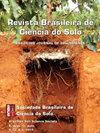Soil quality indicators for monitoring the short-term effects of mined soil rehabilitation strategies for bauxite
IF 2
4区 农林科学
Q3 SOIL SCIENCE
引用次数: 1
Abstract
: Mining is a significant driver of soil mobilization, which impacts its physical, chemical, and biological properties. Changes in land-use affect the distribution of organic matter fractions in stable aggregates, a process that is still poorly understood, especially in drastically altered areas. Recovering and monitoring soil quality to ensure the sustainable development of agricultural crops in these areas after mining is challenging. This study aimed to evaluate the influence of agronomic practices in soil rehabilitation in a bauxite-mined area after three years of field experiment installations through an assessment of organic properties in soil and aggregate classes; an attempt was also made at proposing and elaborating a Soil Quality Index (SQI), which encompasses the soil’s physical, chemical, and organic properties. Different combinations of fertilization treatments and ground cover plants intercropping with coffee were evaluated as rehabilitation practices. The results showed that after three years of rehabilitation, when organic (OF), chemical (CF), and OF+CF fertilizers were applied to the areas of coffee intercropped with Brachiaria (B), they provided higher C and N contents to the soil and aggregates classes, as well as the compartments of soil organic matter (SOM). The minimum set of soil quality indicators for reclaimed bauxite-mined areas was composed of organic indicators: labile organic carbon (LOC) and mineral-associated organic matter (C-MOM); chemical indicators including pH and effective cation-exchange capacity (t), and physical indicators such as the bulk density (BD) and stable aggregates index in water (SAI W ). The t and pH were the variables most sensitive to the management systems implanted during the rehabilitation of the mined area, and, therefore, were considered the best indicators of soil quality. Brachiaria was the cover plant that contributed most to improving the soil quality of mined bauxite areas by increasing the SQI, especially when fertilized. In general, when applied to the Brachiaria, the OF+CF fertilization presented a SQI of 0.78, differing statistically from that of the natural vegetation (1.00). Fertilizers and cover crops in association with coffee in the bauxite-mined areas improved the physical, chemical, and organic properties of the soil, thus representing a viable option for reconditioning mineral exploration areas监测铝土矿开采土壤修复策略短期效果的土壤质量指标
本文章由计算机程序翻译,如有差异,请以英文原文为准。
求助全文
约1分钟内获得全文
求助全文
来源期刊

Revista Brasileira De Ciencia Do Solo
农林科学-土壤科学
CiteScore
3.00
自引率
11.80%
发文量
32
审稿时长
9-24 weeks
期刊介绍:
The Revista Brasileira de Ciência do Solo is a scientific journal published by the Brazilian Society for Soil Science (SBCS), founded in 1947, and is responsible for the propagation of original and inedited technical-scientific work of interest for Soil Science.
Contributions must not have been previously published or submit to other periodicals, with the only exception of articles presented in summarized form at professional meetings. Literature reviews are accepted when solicited by the Editorial Board.
 求助内容:
求助内容: 应助结果提醒方式:
应助结果提醒方式:


